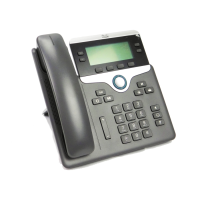Usage NotesPurposeNetwork Protocol
Like other VoIP protocols, SIP is
designed to address the functions of
signaling and session management
within a packet telephony network.
Signaling allows call information to
be carried across network boundaries.
Session management provides the
ability to control the attributes of an
end-to-end call.
SIP is the Internet Engineering Task
Force (IETF) standard for multimedia
conferencing over IP. SIP is an
ASCII-based application-layer control
protocol (defined in RFC 3261) that can
be used to establish, maintain, and
terminate calls between two or more
endpoints.
Session Initiation Protocol
(SIP)
Cisco IP Phones use SRTP for media
encryption.
SRTP is an extension of the Real-Time
Protocol (RTP) Audio/Video Profile and
ensures the integrity of RTP and
Real-Time Control Protocol (RTCP)
packets providing authentication,
integrity, and encryption of media packets
between two endpoints.
Secure Real-Time Transfer
protocol (SRTP)
Cisco IP Phones use TCP to connect
to Cisco Unified Communications
Manager and to access XML
services.
TCP is a connection-oriented transport
protocol.
Transmission Control
Protocol (TCP)
When security is implemented, Cisco
IP Phones use the TLS protocol when
securely registering with the Cisco
Unified Communications Manager.
For more information, see the
documentation for your particular
Cisco Unified Communications
Manager release.
TLS is a standard protocol for securing
and authenticating communications.
Transport Layer Security
(TLS)
TFTP requires a TFTP server in your
network, which can be automatically
identified from the DHCP server. If
you want a phone to use a TFTP
server other than the one specified
by the DHCP server, you must
manually assign the IP address of the
TFTP server by using the Network
Setup menu on the phone.
For more information, see the
documentation for your particular
Cisco Unified Communications
Manager release.
TFTP allows you to transfer files over the
network.
On the Cisco IP Phone, TFTP enables
you to obtain a configuration file specific
to the phone type.
Trivial File Transfer
Protocol (TFTP)
Cisco IP Phones transmit and receive
RTP streams, which utilize UDP.
UDP is a connectionless messaging
protocol for delivery of data packets.
User Datagram Protocol
(UDP)
Cisco IP Phone 7800 Series Administration Guide for Cisco Unified Communications Manager
13
Supported Network Protocols

